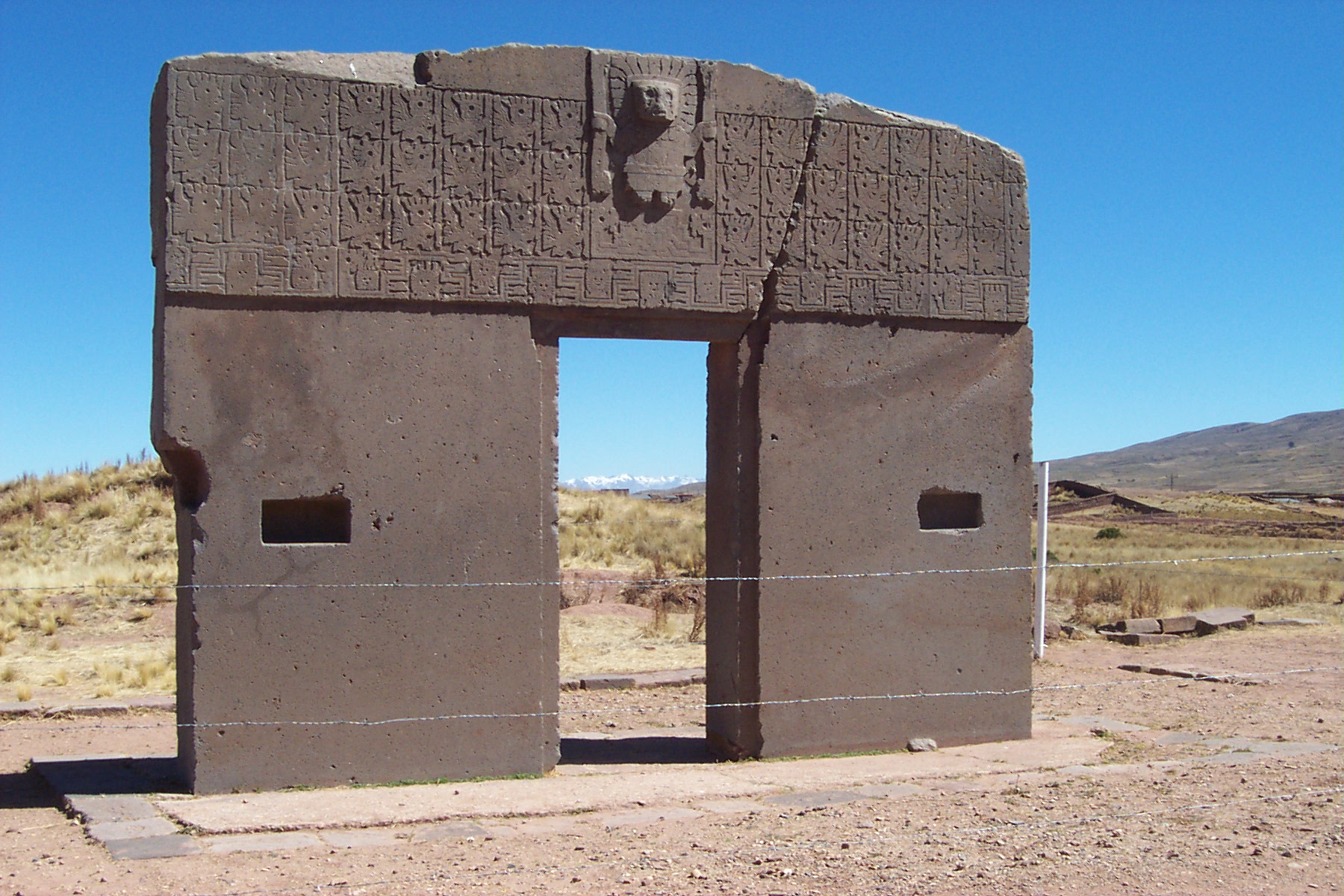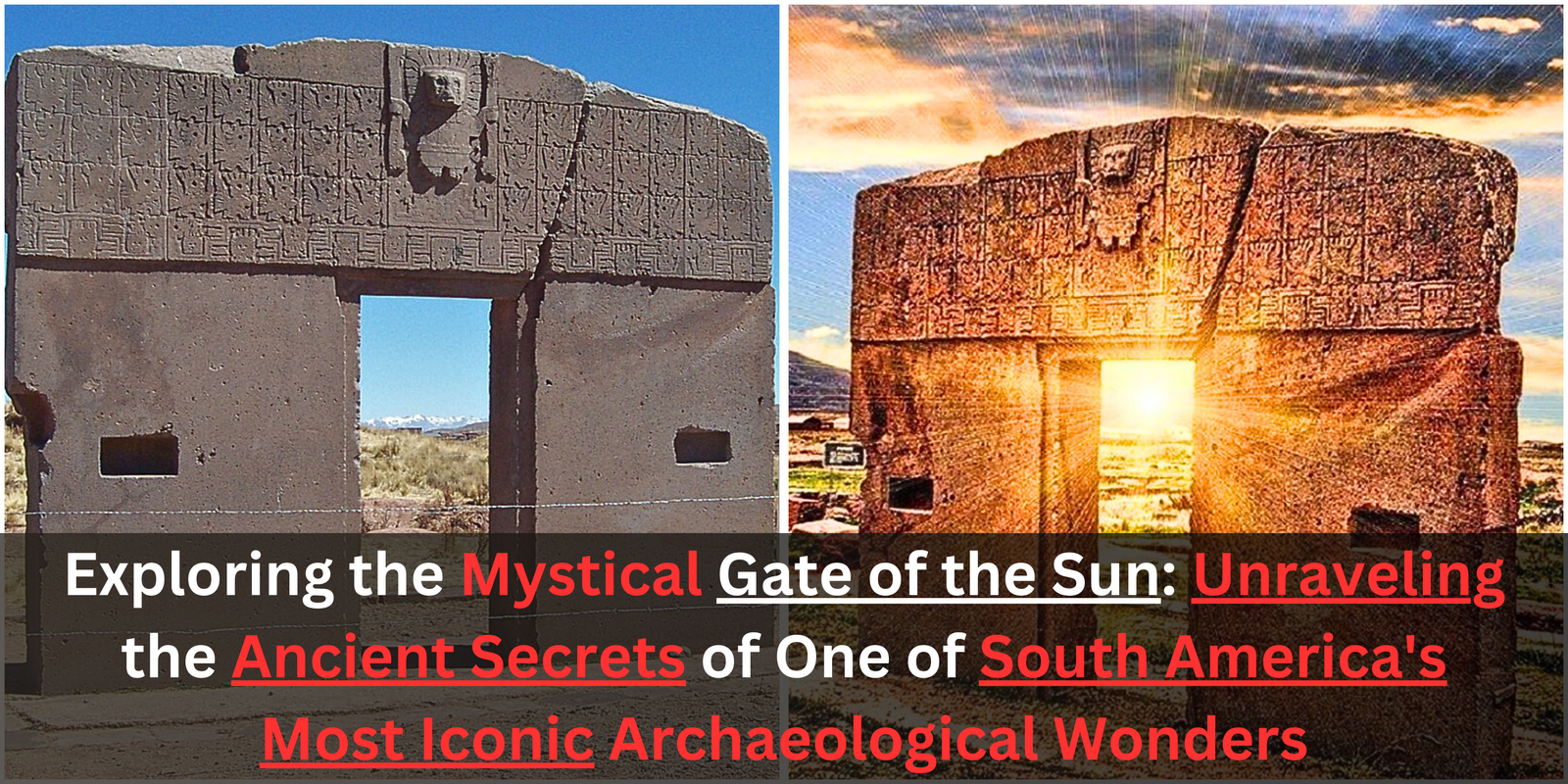Introduction to Gate of the Sun
The Gate of the Sun, alternatively known as Gateway of the Sun (in older books simply referred to as “(great) monolithic Gateway of Ak-kapana,” is a monolithic gateway at the location of Tiahuanaco by the Tiwanaku civilization, an Andean culture of Bolivia that flourished around Lake Titicaca in the Andes of western South America around 500-950 AD.

Tiwanaku lies close to Lake Titicaca at approximately 12,549.2 ft (3,825.0 m) sea level close to La Paz, Bolivia. The Gate of the Sun is about 9.8 ft (3.0 m) high and 13 ft (4.0 m) in width, and was sculpted from one block of stone. It is estimated to weigh 10 tons. When it was rediscovered by European explorers in the mid-19th century, the megalith was horizontal and had a big crack running through it. It now stands in the position where it was discovered, though it is thought that this is not its original location, which is still unknown.
Certain aspects of Tiwanaku iconography disseminated across Peru and parts of Bolivia. While many different modern analyses of the cryptic inscriptions on the artifact have been attempted, the carvings which adorn the gate are thought to have astronomical and/or astrological meaning and to have been used for calendrical purposes. Also, scholars opine that the pattern beneath the central image is intended to portray celestial cycles. As a subsequent monument to the location where it is situated, the Gateway of the Sun may also have symbolized a shift away from lunar religion to a solar religion based on its orientation to the sun in the West.
The study of pseudoarchaeology
Arthur Posnansky and Edmund Kiss were two of the first researchers to examine the Gate of the Sun. They both interpreted the monument in light of false beliefs of early interaction with Nordic Aryans. Their interpretations are today considered pseudoarchaeology as they lacked contemporary data and techniques.
Figures
The frieze at the front of the Gateway presents SAIS (“Southern Andean Iconographic Series”) Iconography. The ornaments and figures in the outer parts which do not present strong lines like the central part were introduced secondarily. It presents 48 (initially 30) attendant figures usually referred to as “attendants”. There are 32 (initially 20) attendants with human heads and 16 (initially 10) anthropomorphic figures with bird heads.
They all converge to the central theme: a human or humanoid figure in Staff God stance (a religious Andean symbol) with 24 linear “rays” around its head, assumed by some to symbolize rays of the Sun. But other interpretations than “rays of the sun” exist. The vertical object in the central figure’s left hand is a stylized Spear-thrower.
Certain historians and archaeologists have proposed that the figure at the center can be the Inca deity Viracocha or Aymara storm god Thunupa. Others believe that it is conceivable that weapons can refer to human beings of a non-superatural kind. The spatial grouping of Tiwanaku “Staff Gods” can demonstrate that the figures are representatives of ritualists.
As proof of the Tiwanaku impact on Inca mythology and iconography, scholars have made similarities between the Inca and Tiwanaku images.
Historical representations



Some Mysteries related to Gate of the Sun
1. What is the Significance of the Gate of the Sun in Ancient Andean Culture?
The Gate of the Sun is an ancient archaeological structure located in the ruins of Tiwanaku, Bolivia, near Lake Titicaca. It is considered one of the most important monuments in pre-Columbian Andean culture. Dating back to approximately 400-500 AD, the Gate of the Sun was believed to serve as a ceremonial gateway and a symbol of the connection between the terrestrial and celestial realms. Its intricate carvings, particularly the central figure of a deity, have led many researchers to speculate about its spiritual and astronomical significance.
The monument is made of a single massive stone, weighing around 10 tons. Its detailed carvings depict a prominent figure that is interpreted as Viracocha, the creator god in Inca mythology, though the Tiwanaku people had a different pantheon of deities. The Gateway itself is thought to have been aligned with the sun’s movement, particularly during solstices, which suggests that the Tiwanaku civilization may have used it for astronomical observation.
The Gate of the Sun also appears to be aligned with other structures in Tiwanaku, which further suggests its role in an ancient system of astronomy and timekeeping. The site itself is thought to have been a ceremonial center, and the Gateway could have been used for rituals that marked the changing of seasons or key agricultural moments. The fact that the gate faces east, where the sun rises, makes it an important feature for sun worship, which was central to Andean spiritual practices.
Scholars continue to debate the exact purpose of the gate. Some argue that it could have served as a portal for deities to enter and exit the earthly realm, while others propose it was simply a marker for religious ceremonies or celestial observations. Its intricate carvings may also hint at advanced knowledge of mathematics and geometry, making the Gate of the Sun an object of wonder and intrigue even today.
There is a prevailing mystery about the advanced techniques used to transport and carve such large stones. Tiwanaku’s civilization was likely not as technologically advanced as some other contemporaneous cultures like the Maya or Egyptians, which raises questions about how they were able to construct such a massive and precise monument. This has led to many theories, ranging from the plausible to the fantastical, about external influences or lost technologies.
In conclusion, the Gate of the Sun is not only a symbol of ancient Andean culture but also a fascinating puzzle for archaeologists, historians, and astronomers alike. Its significance continues to be explored, and its mysteries surrounding its purpose, construction, and cultural importance remain subjects of debate and discovery.
2. How Was the Gate of the Sun Constructed with Such Precision?
The construction of the Gate of the Sun remains one of the most remarkable feats of the Tiwanaku civilization. Made from a single monolithic block of stone, the gateway is an architectural marvel, considering the relatively primitive tools and technology available at the time. The precision with which the stone was carved and the structure was aligned to the cardinal directions raise intriguing questions about how the Tiwanaku people achieved such advanced engineering.
The most widely accepted theory is that the builders of the Gate of the Sun used rudimentary tools to shape the stone. These tools would have been made from harder materials such as copper, stone, or bronze, but the precise methods of shaping and carving the monolith remain unclear. The gate itself is cut with remarkable accuracy, suggesting that the Tiwanaku people had an advanced understanding of geometry and design.
Another mystery lies in the transportation of such a heavy stone. The Gate of the Sun weighs about 10 tons, which would have been an enormous challenge to transport without the use of modern machinery. Some scholars propose that the builders used a system of ramps and levers to move the stone, while others speculate that the stone may have been worked on-site from a nearby quarry. However, no definitive evidence of such techniques has been found.
One intriguing aspect of the construction is the alignment of the Gate with celestial events. The stone’s orientation towards the east, where the sun rises, suggests that the builders had a sophisticated understanding of astronomy. Some researchers believe that the Gate was not just a monument but a tool for marking the passage of time, with its precise alignment to the sun marking key events such as solstices or equinoxes.
The exact methods of quarrying and shaping the stones remain a subject of debate. Some theories propose that the stones were carved using abrasives like sand, while others suggest that a more complex technique, possibly involving heat or other unknown methods, was used. The fact that the stones fit so perfectly together without the use of mortar raises further questions about the techniques used.
In conclusion, while many aspects of the construction of the Gate of the Sun remain mysterious, the precision and craftsmanship suggest a level of knowledge and skill that was advanced for its time. The theories regarding its construction continue to evolve, making the monument a key piece in understanding the capabilities of the ancient Tiwanaku civilization.
3. Does the Gate of the Sun Serve as a Calendar or Astronomical Observatory?
One of the most enduring mysteries surrounding the Gate of the Sun is its possible role as an astronomical observatory or calendar. The gate’s alignment with the sun and the intricate carvings on its surface suggest that it may have been used for celestial observations, particularly to track the movements of the sun and other celestial bodies.
The most significant alignment is its eastward orientation, which faces the sunrise. This has led many scholars to suggest that the Gate was used to mark the passage of time, with its alignment indicating key solar events such as the solstices and equinoxes. In fact, many ancient civilizations around the world built structures that aligned with the sun’s position on these important dates, and the Tiwanaku people may have done the same.
Another feature that hints at the Gate’s role as a timekeeping device is the carvings that adorn the stone. These include a central figure that some believe represents Viracocha, the creator god, as well as various geometric symbols. Some researchers believe that these symbols could have had astronomical significance, marking the positions of the stars or planets at particular times of the year. It is possible that the carvings served as a guide for rituals and ceremonies that were based on the solar calendar.
Some theories suggest that the Gate of the Sun was part of a larger complex of astronomical structures in Tiwanaku. If this were the case, it could have been used in conjunction with other monuments to create a more comprehensive system for tracking celestial events. The site’s alignment with other nearby structures, such as the semi-subterranean temple, strengthens the possibility that Tiwanaku was a hub for astronomical and ceremonial activities.
In addition to its role as a calendar, the Gate of the Sun may have had a ritualistic function. It could have been used to mark the changing of seasons, which was vital for the agricultural society of the Tiwanaku people. The ceremonies that took place at the Gate may have been intended to ensure the proper alignment of the cosmos with the earthly realm, reinforcing the idea that the Gate served as a portal between the two.
The mystery of whether the Gate of the Sun was a true astronomical observatory or simply a ceremonial monument remains unresolved. While its alignment with solar events is clear, the extent to which it was used for precise astronomical measurements is still a matter of debate.
4. Why Was the Gate of the Sun Abandoned and Left in Ruins?
The abandonment of the Gate of the Sun and the surrounding Tiwanaku site is one of the most intriguing aspects of its history. At its height, Tiwanaku was a powerful and sophisticated civilization, but by the time Spanish explorers arrived in South America, the site had already been largely abandoned. What led to the decline of Tiwanaku, and why was the Gate of the Sun left in ruins?
Several factors are believed to have contributed to the collapse of Tiwanaku. One of the most prominent theories is environmental change. It is widely believed that the region experienced significant climate fluctuations that may have led to crop failures, droughts, or other environmental stresses. This would have been disastrous for an agrarian society like Tiwanaku, which relied heavily on agriculture for its survival.
Another theory is that the collapse was caused by internal social or political factors. The Tiwanaku civilization was highly organized, with complex religious and political structures, but these systems may have become unstable over time. Some researchers speculate that the rulers of Tiwanaku lost control over their subjects, leading to internal strife and eventual abandonment of the site.
The idea of a sudden and catastrophic event is also possible. Some theories propose that the Tiwanaku civilization could have been devastated by an invasion from outside forces, although there is little evidence to support this. Alternatively, a natural disaster, such as an earthquake or volcanic eruption, could have caused widespread damage to the city and its monuments.
Despite these possible explanations, there is no conclusive evidence to explain why the Gate of the Sun, in particular, was left behind. It is possible that the site continued to hold spiritual or ceremonial significance even after the city’s abandonment, with later inhabitants choosing to leave the monument undisturbed. The site may have been seen as sacred or as a relic of a lost civilization.
Another possibility is that the Gate was left intact as a form of tribute or memory. In many ancient cultures, monuments were built to honor deities or ancestors, and the Tiwanaku people may have chosen to leave the Gate of the Sun as a symbol of their culture’s enduring legacy, even if the city itself fell into ruin.
In the end, the true reasons behind the abandonment of the Gate of the Sun and the Tiwanaku civilization remain an open question. The mysteries surrounding its decline continue to captivate historians and archaeologists, offering more avenues for research and exploration.
5. What Is the Connection Between the Gate of the Sun and the Inca Empire?
Although the Gate of the Sun predates the Inca Empire by several centuries, there is evidence to suggest a connection between the two cultures. The Inca, who rose to power much later than the Tiwanaku civilization, had a deep reverence for the past and often incorporated elements of earlier Andean cultures into their own religious and architectural traditions.
The most obvious connection is the similarity between the religious iconography found on the Gate of the Sun and that of the Inca. The central figure carved into the Gate is often identified as Viracocha, the creator god of the Andean pantheon, who was also an important deity in Inca religion. This suggests that the Inca were aware of and perhaps even influenced by the religious practices of the Tiwanaku people.
Additionally, the Inca Empire expanded into the regions that were once part of the Tiwanaku civilization, and it is likely that they encountered the ruins of Tiwanaku during their conquests. The Inca were known for assimilating aspects of local cultures into their own, and it is possible that they adopted some of the religious practices or architectural styles from Tiwanaku.
Inca rulers were also highly interested in celestial phenomena, particularly the sun, which was central to their religious beliefs. The alignment of the Gate of the Sun with the sunrise may have influenced the Inca’s own architectural designs, including their sun temples and other religious structures.
Despite the connection, the Inca did not build the Gate of the Sun, and there is no evidence that they used it for the same purposes as the Tiwanaku people. However, it is possible that the Inca saw the monument as a sacred site, and they may have maintained its significance in their own rituals and ceremonies.
Ultimately, the relationship between the Gate of the Sun and the Inca Empire highlights the continuity of Andean culture over time. The reverence for celestial events and the worship of deities like Viracocha persisted long after the fall of the Tiwanaku civilization, and the Inca played a key role in preserving and adapting these traditions.
6. Could the Gate of the Sun Have Been Used for Ceremonial Sacrifice?
One of the more somber mysteries surrounding the Gate of the Sun involves the possibility that it was used for ceremonial sacrifice. Many ancient cultures in the Andes practiced ritual sacrifice, and the Tiwanaku civilization, with its strong religious and astronomical traditions, may have also participated in such practices.
There are no direct signs of human sacrifice at the Gate of the Sun itself, but the proximity of the monument to other ceremonial sites in Tiwanaku raises the possibility that it could have been used for such rituals. The Tiwanaku people were deeply religious and likely saw the Gate as a portal to the divine. It is plausible that ceremonies held at the site could have involved offerings to the gods, including human sacrifice, which was a common feature in Andean religion.
The fact that the Tiwanaku civilization placed great importance on the sun and celestial movements suggests that their sacrifices were likely tied to agricultural cycles. Sacrifices were often made during key moments of the solar calendar, such as solstices and equinoxes, to ensure a successful harvest or to appease the gods.
However, there is limited archaeological evidence to suggest that human sacrifice took place at the Gate of the Sun specifically. While human remains have been found at other Tiwanaku sites, the direct link between those remains and the Gate is not clear. Some researchers believe that the sacrifices may have taken place at other locations within the Tiwanaku complex, such as the semi-subterranean temple.
Despite the lack of direct evidence, the possibility that the Gate of the Sun was used for ceremonial sacrifice remains an open question. The sacred nature of the site and its alignment with celestial events makes it a likely candidate for the performance of such rituals. However, further archaeological excavations and research would be needed to confirm whether or not sacrifices were made there.
7. Did the Tiwanaku People Have Advanced Technology to Construct the Gate of the Sun?
The question of whether the Tiwanaku civilization possessed advanced technology capable of building the Gate of the Sun has been a subject of much speculation. The impressive size, precision, and alignment of the structure suggest a level of technological skill that is surprising for a civilization that predates modern machinery.
Some researchers have posited that the Tiwanaku people may have had knowledge of advanced building techniques that have since been lost to history. The precise carving of the monolithic stone and the perfect fit of its edges suggest a level of craftsmanship that is not easily explained by the tools available at the time.
One theory is that the Tiwanaku people may have used simple tools like copper or stone implements to carve and shape the massive stone. Others believe that they could have used heat or other methods to soften the rock before working it into the desired shape. However, no evidence of these techniques has been conclusively found at the site.
The mystery of how such a massive stone could be moved and carved remains unsolved. The transportation of the stone would have required great ingenuity, as it is unlikely that the Tiwanaku people had the wheel or advanced lifting devices. Some have suggested that the stones were dragged using ropes and manpower, while others have speculated that the builders used ramps or other methods to position the stone.
Despite the lack of clear evidence for advanced technology, the precision of the Gate of the Sun raises important questions about the capabilities of ancient civilizations. The monument stands as a testament to the ingenuity and skill of the Tiwanaku people, even as we continue to search for answers to the mystery of how it was constructed.
8. What Role Did the Sun Play in Tiwanaku’s Religious and Cultural Practices?
The Sun played a pivotal role in the religious and cultural practices of the Tiwanaku civilization. As with many ancient Andean cultures, the Tiwanaku people believed that the Sun was a central force in both their spiritual and agricultural life. The Gate of the Sun, with its precise alignment towards the sunrise, is a reflection of this profound connection to celestial bodies, specifically the Sun.
The Tiwanaku civilization placed great importance on the cycles of the Sun, using them to guide their agricultural practices. The Sun was seen not only as a provider of light and warmth but also as a life-giving force that ensured the fertility of the land. It is believed that the Tiwanaku people marked important solar events, such as solstices, to time their planting and harvesting. This alignment likely had a significant impact on their ability to manage food resources and sustain their society.
In religious terms, the Sun was often associated with powerful deities. Viracocha, the creator god in Tiwanaku mythology, was linked to the Sun, and the Gate of the Sun may have been a symbolic entry point through which this deity could connect with the people. Some interpretations suggest that the figure carved into the center of the gate represents Viracocha, emphasizing the importance of solar worship in the Tiwanaku belief system.
Moreover, the Sun’s cycles were deeply integrated into the ceremonial life of the Tiwanaku. Major rituals were likely conducted at significant solar events to honor the gods and ensure the continued prosperity of the community. The Gate of the Sun may have been central to such rituals, serving as a portal through which participants could access divine favor during key moments of the solar year.
The relationship between the Sun and Tiwanaku culture also extended beyond agriculture and religion. Sun worship was woven into the very fabric of their social structure, and the performance of solar-related ceremonies could have reinforced social cohesion, cementing the roles of priests and leaders in guiding these important spiritual events.
In sum, the Sun’s role in Tiwanaku life was essential, shaping their worldview, agricultural calendar, and religious practices. The Gate of the Sun serves as a monument to this relationship, standing as a lasting reminder of how the Tiwanaku civilization revered the Sun and its power.
9. What Is the True Meaning of the Symbols Carved on the Gate of the Sun?
The Gate of the Sun is adorned with intricate carvings, many of which remain enigmatic to this day. The most notable feature is the central figure, often interpreted as Viracocha, the creator god, but surrounding this figure are various geometric patterns and other symbols that may hold deeper meaning. Decoding these symbols has been a subject of great interest among archaeologists and historians, as they could offer insights into the religious, cultural, and astronomical knowledge of the Tiwanaku people.
Some scholars have suggested that the symbols on the Gate of the Sun represent the Tiwanaku’s cosmological understanding. The geometric patterns could be representations of the celestial world, perhaps linked to the positions of stars or the movement of the Sun and moon. The central figure of Viracocha may symbolize the connection between the gods and the earth, and the surrounding symbols might represent the forces that govern the cosmos.
Additionally, the presence of other motifs, such as faces, humanoid figures, and animal representations, could point to the Tiwanaku’s complex pantheon of gods. These deities were likely associated with natural elements such as the earth, water, and sky. Some interpretations propose that the figures could be representations of mythical beings, linking the celestial realm with the earthly plane and reflecting the spiritual beliefs of the Tiwanaku people.
The alignment of the Gate itself with the cardinal directions and the Sun’s movements suggests that the symbols may also have had an astronomical function. They might have served as a guide to important dates in the solar calendar, helping the Tiwanaku people track the passage of time and mark key moments such as solstices and equinoxes.
However, the exact meaning of the symbols remains elusive. Unlike other ancient cultures, the Tiwanaku people did not leave behind written records explaining the significance of their carvings, making it difficult to interpret them with certainty. It’s possible that the symbols held a deeper, esoteric meaning known only to the priests and elites of the Tiwanaku society.
In conclusion, the symbols on the Gate of the Sun are rich with potential meaning, but their full interpretation continues to evade researchers. Whether they represent astronomical knowledge, religious beliefs, or a combination of both, these enigmatic carvings continue to be a focal point of study and a testament to the complexity of Tiwanaku culture.
10. Could the Gate of the Sun Hold Secrets About Lost Ancient Technologies?
One of the most tantalizing mysteries surrounding the Gate of the Sun is the possibility that it could hold clues to lost ancient technologies. The precision of its construction, the massive size of the stone, and the alignment with celestial events all point to a level of sophistication that raises questions about the technology available to the Tiwanaku civilization.
The idea of lost ancient technologies is a recurring theme in the study of ancient civilizations. Some researchers propose that the Tiwanaku people may have possessed knowledge or tools that have since been lost to history, which would explain the impressive craftsmanship of the Gate of the Sun. If such technologies existed, they could have involved advanced methods of carving and transporting large stones or even an understanding of materials that allowed for such precision.
The question of how the Tiwanaku were able to move and carve stones weighing several tons has led to various theories. Some suggest that they may have used a form of vibration or sound to manipulate the stone, or that they possessed a method of softening or shaping the rock in ways that are not understood today. While these ideas are speculative, they reflect the ongoing intrigue surrounding ancient technologies that could have been more advanced than we currently realize.
In addition, the perfect alignment of the Gate of the Sun with solar and celestial events suggests that the Tiwanaku had a deep understanding of astronomy, potentially more sophisticated than what is commonly believed for the time. Some have wondered if the Tiwanaku might have had knowledge of advanced astronomical instruments or techniques to track celestial bodies with such accuracy.
Though the Gate of the Sun remains a stunning example of ancient craftsmanship, the idea that it might hold secrets of lost technologies is speculative. As with many other ancient structures around the world, the full extent of the Tiwanaku civilization’s capabilities remains a mystery, and the Gate of the Sun is a focal point for those searching for answers.
In the end, the possibility that the Gate of the Sun is linked to lost technologies speaks to the broader mystery of how ancient civilizations achieved such remarkable feats with what we perceive to be primitive tools. Until further discoveries are made, the Gate of the Sun will continue to stand as an enigmatic monument to the potential hidden in ancient cultures.
Latest Updates







 Let’s imagine, explore, and uncover the mysteries together!
Let’s imagine, explore, and uncover the mysteries together!